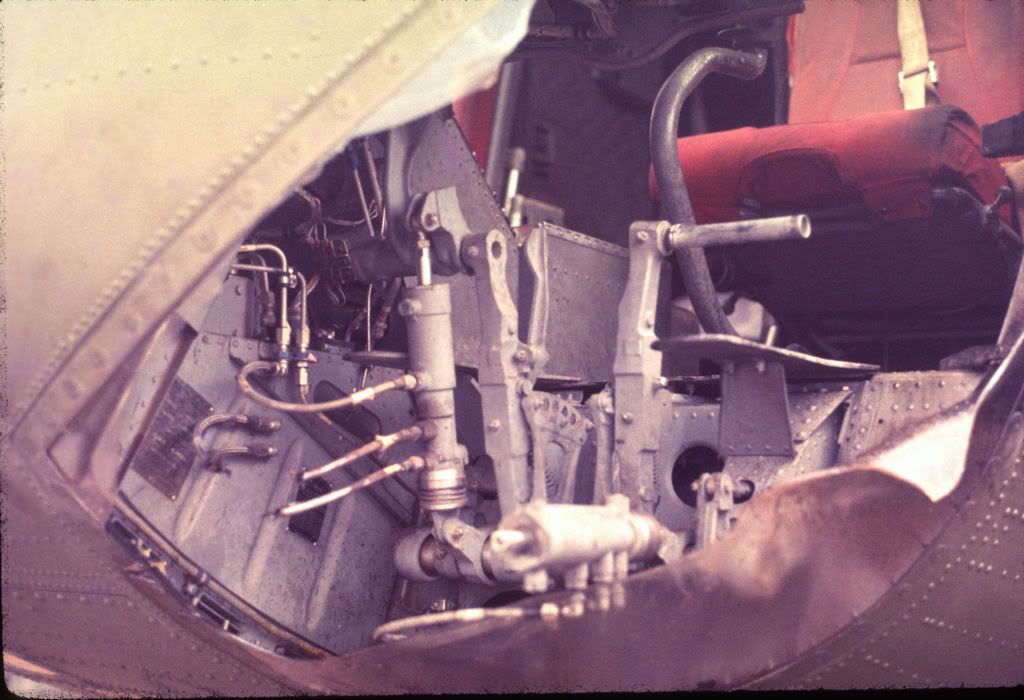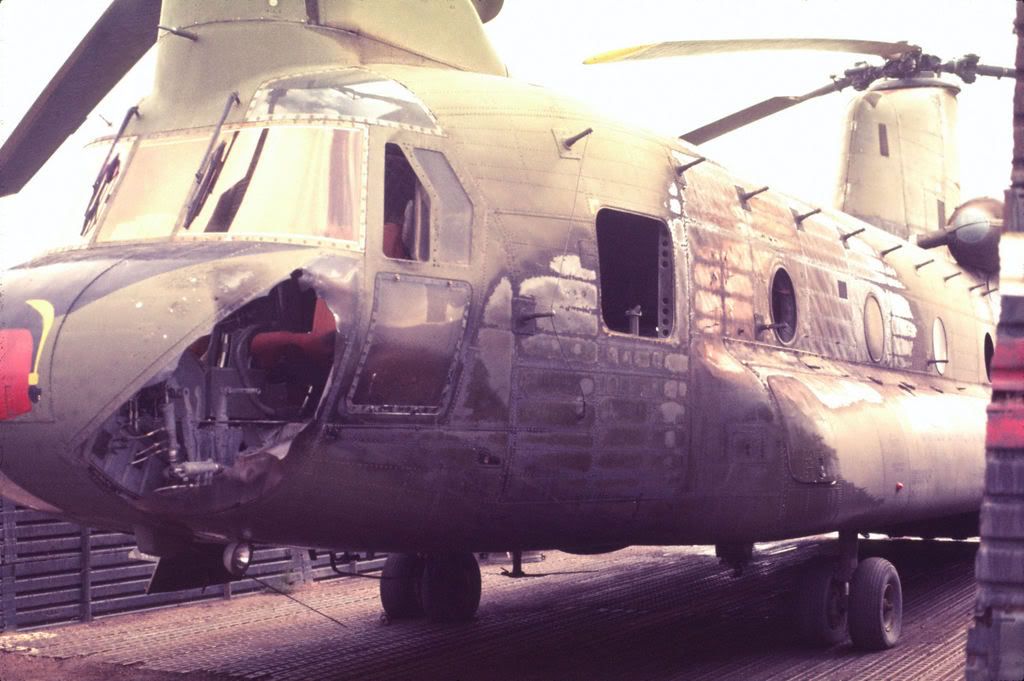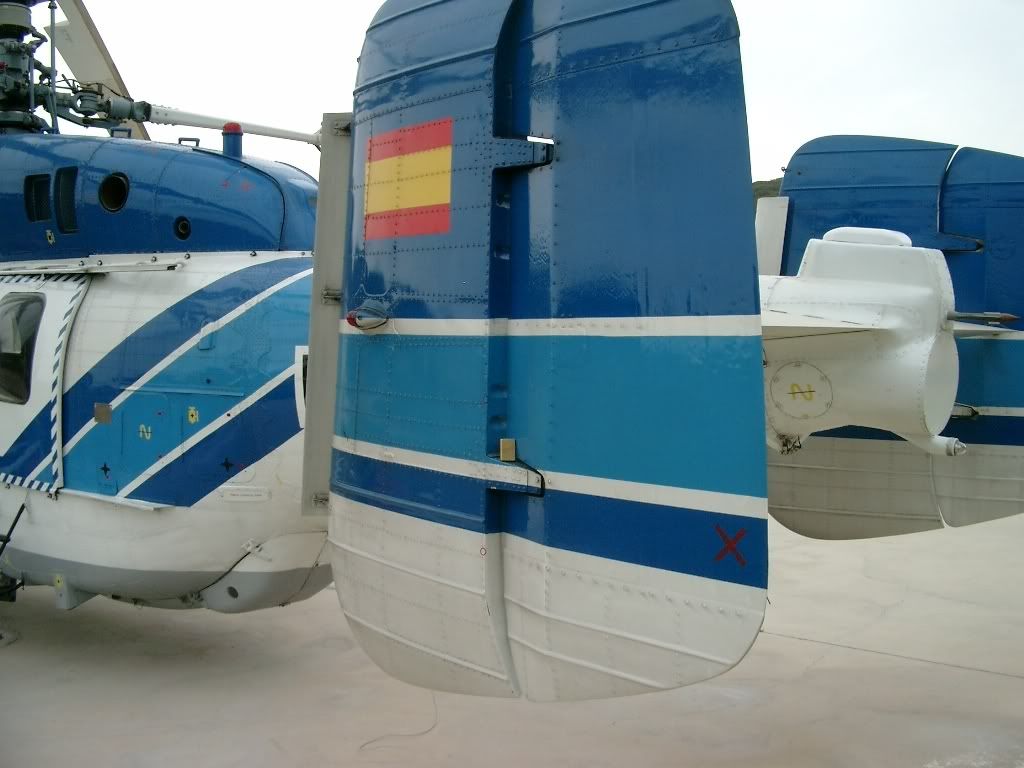Helicopter rudder pedals
Thread Starter
I appreciate that on most helicopters the rudder pedals control yaw through the tail rotor, but how do they work on twin rotor machines?
What, helicopters now have rudders? 

Sorry, I couldn't help myself. FYI, the pedals in a helicopter control the anti-torque device (ie the tail rotor in most designs).
But when you say 'twin rotor', do you mean a tandem machine (like a Chinook) or a co-axial design (like a Kamov)?
Edited to add:
Just did a quick bit of Googling and this site should answer all of your questions, Dr Jeckyll:
Helicopter Yaw Control Methods
HTH


Sorry, I couldn't help myself. FYI, the pedals in a helicopter control the anti-torque device (ie the tail rotor in most designs).
But when you say 'twin rotor', do you mean a tandem machine (like a Chinook) or a co-axial design (like a Kamov)?
Edited to add:
Just did a quick bit of Googling and this site should answer all of your questions, Dr Jeckyll:
Helicopter Yaw Control Methods
HTH
Last edited by Bravo73; 14th Sep 2007 at 14:11.
Join Date: Nov 2006
Location: UK
Posts: 117
Likes: 0
Received 0 Likes
on
0 Posts
I believe that in a Chinook the "rudder peddles" change the pitch between the front and rear rotors thus changing the direction of the torque reaction...
For an object to be at rest, for every action, there must be an equal and opposite reaction....so by changing the torque of the rotors differentially you are upsetting this balance...
For an object to be at rest, for every action, there must be an equal and opposite reaction....so by changing the torque of the rotors differentially you are upsetting this balance...
 Come On SASless, where are you when one needs you?
Come On SASless, where are you when one needs you?As an experienced RVN CH-47 PIC you must know.
Well....since I was called out on this topic....my immediate answer is by means of "PFM".
As it was two generations ago I herded Chinooks about the sky...my technical grasp of the topic is a bit dim.
All those excuses being made....I will try to do my best to explain it in very simple terms (operative word in my case is "simple").
Each rotor head on the Chinook has two actuators, one being called the
"Swiveling Actuator" and the other the "Pivoting Actuator". The actuators work together to provide differential cyclic and collective pitch for the head. There is no "collective actuator" as in single rotor helicopters.
Yaw control is very similar in result as in making a cyclic movement in a single rotor helicopter....except the rotor heads are "tilted" in opposite directions by means of input through the "Yaw Control Pedals".
As Torque is countered by the contra-rotating rotors, there is no "Yaw" as typical of single rotor helicopters.
Collective Sticks are known as "Thrust Levers" in the Chinook.
One of the final tests for a Chinook Instructor qualification used to be having to explain the movements of the flight controls and the resulting actuator movements produced while hovering....the tough part was when the maneuver being discussed was a turn about a point with a fixed radius measured from the Aft Head while encountering a ten knot wind.
I doubt anyone got past the first ten seconds of the explanation before getting totally flumoxed.
This is a photo of a slightly used set of Chinook Yaw Control Pedals....

For a bit of perspective....

As it was two generations ago I herded Chinooks about the sky...my technical grasp of the topic is a bit dim.
All those excuses being made....I will try to do my best to explain it in very simple terms (operative word in my case is "simple").
Each rotor head on the Chinook has two actuators, one being called the
"Swiveling Actuator" and the other the "Pivoting Actuator". The actuators work together to provide differential cyclic and collective pitch for the head. There is no "collective actuator" as in single rotor helicopters.
Yaw control is very similar in result as in making a cyclic movement in a single rotor helicopter....except the rotor heads are "tilted" in opposite directions by means of input through the "Yaw Control Pedals".
As Torque is countered by the contra-rotating rotors, there is no "Yaw" as typical of single rotor helicopters.
Collective Sticks are known as "Thrust Levers" in the Chinook.
One of the final tests for a Chinook Instructor qualification used to be having to explain the movements of the flight controls and the resulting actuator movements produced while hovering....the tough part was when the maneuver being discussed was a turn about a point with a fixed radius measured from the Aft Head while encountering a ten knot wind.
I doubt anyone got past the first ten seconds of the explanation before getting totally flumoxed.
This is a photo of a slightly used set of Chinook Yaw Control Pedals....

For a bit of perspective....

Last edited by SASless; 14th Sep 2007 at 18:33.
Join Date: Sep 2007
Location: In the hotseat
Age: 58
Posts: 8
Likes: 0
Received 0 Likes
on
0 Posts
Rudder control in contra rotors
Well, in helicopters like Kamovs with contra-rotating rotors, a mechanism called CDPCM (Collective Differential Pitch Control Mechanism) is used, in addition to LARGE rudders with slats. when the pilot applies rudder, CDPCM causes the pitch angle of both upper and lower rotors to change appropriately so as to provide the required yaw. Needless to say, if in forward flight with rudders effective, the pedal deflection necessary is reduced. The Control Law calculation and the gearing required for the above is actually amazing and hats off to Russian engineering. Notwithstanding, while taxiing in such helicopters, one sometimes needs to come up on collective significantly to effect a sharp turn.
Join Date: Sep 2007
Location: USA
Posts: 336
Likes: 0
Received 0 Likes
on
0 Posts
Helicoptertestpilot:
Since you have some knowledge about the mechanism of the KA 32,maybe you can help here:
I have heard thet the KA is a b---- to fly on instruments.Roll into a turn, apply rudder to center the ball and voila!the helicopter climbs( or descends --depending on which rudder has been applied).True or false?
Alt3
Since you have some knowledge about the mechanism of the KA 32,maybe you can help here:
I have heard thet the KA is a b---- to fly on instruments.Roll into a turn, apply rudder to center the ball and voila!the helicopter climbs( or descends --depending on which rudder has been applied).True or false?
Alt3
Join Date: Aug 2004
Location: USA (Naturalized but bits still British!)
Posts: 103
Likes: 0
Received 0 Likes
on
0 Posts
Bravo
on the drawings for the Ch54 / S64, good old Igor's boys refer to the "rotary rudder"
So they are "pedals, rotary rudder"
It also has "alighting gear".........
on the drawings for the Ch54 / S64, good old Igor's boys refer to the "rotary rudder"
So they are "pedals, rotary rudder"
It also has "alighting gear".........
Kiinda like going wings level in an Alouette III !
Well, there you go - every day's a training day! 
I would still reason that rudders belong on boats and aeroplanes. But I guess that the Kamov is the exception to that rule...

I would still reason that rudders belong on boats and aeroplanes. But I guess that the Kamov is the exception to that rule...
Most likely something like this....educated guess was something along the lines of .51 Caliber. It makes one very noisy entrance as it passes through....particularly when it hits the pedals you got yer number nines stuck on.
Scary? Trust me.... It is possible to pee and poop simultaneously!
What bothers me to this day is the guy at the other end did not even know me....and he tried to kill me. I could understand it if he actually knew me.


Scary? Trust me.... It is possible to pee and poop simultaneously!
What bothers me to this day is the guy at the other end did not even know me....and he tried to kill me. I could understand it if he actually knew me.


Join Date: Nov 2004
Location: Cambridgeshire, UK
Posts: 1,334
Likes: 0
Received 0 Likes
on
0 Posts
I guess the aircraft and so anyone in it becomes a target. Impressed by your getting the machine down. Pilots with combat experiences earn my respect anyday.
That looks like the result of a hydraulic oil fire? I've seen how quickly it catches on diesel exhaust manifolds.
BTW, back on topic, how did you find the yaw response of the Chook? I imagine all that inertia along with differential cyclic control created a noticeable time lag. I guess that flapback kept the rate in check, but did you have to be gentle about applying/reversing pedals?
That looks like the result of a hydraulic oil fire? I've seen how quickly it catches on diesel exhaust manifolds.
BTW, back on topic, how did you find the yaw response of the Chook? I imagine all that inertia along with differential cyclic control created a noticeable time lag. I guess that flapback kept the rate in check, but did you have to be gentle about applying/reversing pedals?
Last edited by Graviman; 15th Sep 2007 at 19:03.
The Chinook was much easier to control in yaw than any other helicopter I have flown....makes sense in that the Yaw (during power changes) is minimized by the design.
On the ground we had a very small range of travel if all wheels were on the ground...something like an inch either way....but upon lifting the forward gear off the ground and doing a two wheel taxi that limitation went away.
The inertia of the aircraft due to its size and weight aids in cross winds or gusty winds...but the down side is when you let the rate of turn get away from you it takes a Heaps of pedal to get it stopped again.
These fancy photos you see of the Chinook setting on top of a very small ledge or house top makes one think it is really hard to do. From a flight control standpoint it is quite easy really. Finding a reference to use while doing it can be a bit tricky.
The same method used to pick the aircraft up to a hover works for those aft wheel only landings.
Pedals keep the nose straight, the cyclic gets pulled back two inches (used to have a cyclic position indicator in the CH-47 A, B, and C's), then the thrust lever is raised until a 5-7 nose high attitude is reached...brakes can be released at that point and the desired aicraft position is maintained by the thrust lever and pedals....the cyclic rarely needs moving once a balanced position is found. As the folks in back do their thing....thrust lever movements counter the movement from changes in CG caused by loading or unloading.
The one characteristic of the Chinook is both rotorheads want to be in front of the other....and a bitter feud it is too. The original A model's had a sharp ended empennage and later models have a square end which is supposed to give the aeronautical effect of 35 feet of fin. That dampened the yawing of the aircraft when in un-SAS'd flight.
The improvement of yaw control done by the SAS system on the A models is hard to describe to anyone that has not flown the Chinook. On more than one occasion while instructing on the aircraft....we have had the droop stops pounding at a 100 knots in what was rapidly becoming sideways flight as the rear end swung around to one side or the other when the SAS system was turned off. The B-D models are much more stable in yaw than the A model.
On the ground we had a very small range of travel if all wheels were on the ground...something like an inch either way....but upon lifting the forward gear off the ground and doing a two wheel taxi that limitation went away.
The inertia of the aircraft due to its size and weight aids in cross winds or gusty winds...but the down side is when you let the rate of turn get away from you it takes a Heaps of pedal to get it stopped again.
These fancy photos you see of the Chinook setting on top of a very small ledge or house top makes one think it is really hard to do. From a flight control standpoint it is quite easy really. Finding a reference to use while doing it can be a bit tricky.
The same method used to pick the aircraft up to a hover works for those aft wheel only landings.
Pedals keep the nose straight, the cyclic gets pulled back two inches (used to have a cyclic position indicator in the CH-47 A, B, and C's), then the thrust lever is raised until a 5-7 nose high attitude is reached...brakes can be released at that point and the desired aicraft position is maintained by the thrust lever and pedals....the cyclic rarely needs moving once a balanced position is found. As the folks in back do their thing....thrust lever movements counter the movement from changes in CG caused by loading or unloading.
The one characteristic of the Chinook is both rotorheads want to be in front of the other....and a bitter feud it is too. The original A model's had a sharp ended empennage and later models have a square end which is supposed to give the aeronautical effect of 35 feet of fin. That dampened the yawing of the aircraft when in un-SAS'd flight.
The improvement of yaw control done by the SAS system on the A models is hard to describe to anyone that has not flown the Chinook. On more than one occasion while instructing on the aircraft....we have had the droop stops pounding at a 100 knots in what was rapidly becoming sideways flight as the rear end swung around to one side or the other when the SAS system was turned off. The B-D models are much more stable in yaw than the A model.







